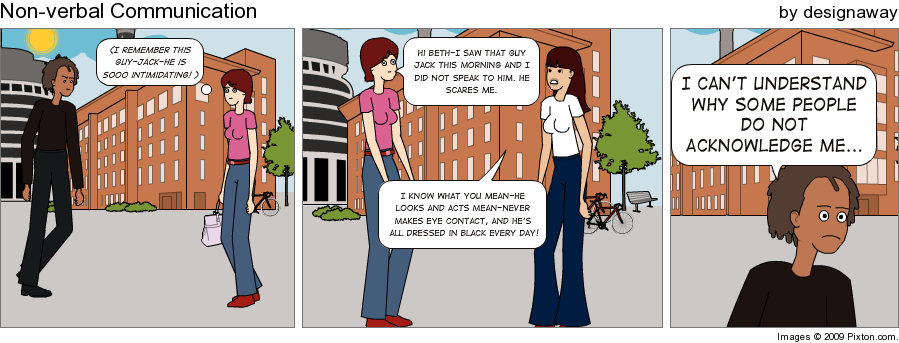Signaling Involvement (or Not)
Exploring Nonverbal Signals of Involvement and Liking
 This is an exercise exploring Nonverbal Communication and how it is used to signal our desired degree of Involvement and Immediacy with another person. As we noted earlier, information about our desired or perceived relationships with others is signaled by our behavior, and much of this is delivered nonverbally. While the following activity is designed as a student activity that could be used in a classroom, please think about it as a tool for becoming more aware of issues related to Involvement and Immediacy. In particular, pay attention to the behaviors related to Immediacy, Expressiveness, Engagement and Composure that are provided in the Observer Checklist below. Think about how these same behaviors might be present in your interactions at school.
This is an exercise exploring Nonverbal Communication and how it is used to signal our desired degree of Involvement and Immediacy with another person. As we noted earlier, information about our desired or perceived relationships with others is signaled by our behavior, and much of this is delivered nonverbally. While the following activity is designed as a student activity that could be used in a classroom, please think about it as a tool for becoming more aware of issues related to Involvement and Immediacy. In particular, pay attention to the behaviors related to Immediacy, Expressiveness, Engagement and Composure that are provided in the Observer Checklist below. Think about how these same behaviors might be present in your interactions at school.
Mall Interaction Role Play (For Use With Your Students?)
Activity Introduction: This is a Nonverbal Role play where a person shopping at a Mall is approached another. The shopper wants as little to do with the other as possible and shows it through non-verbal cues:
Let the students role play for 1-2 minutes.
The second role play is where the shopper is really pleased to see and interact with the other.
What differences did you note in the non-verbal behavior of the participants?
Instructions for Role Play for Nonverbal Involvement Activity:
Objective: To illustrate how people nonverbally communicate low and high involvement.
Introduce the scene to all participants. Share observer instructions with the observers only. Privately instruct the two volunteer role players in version 1 and then act out version 1. Privately instruct the two role players in version 2 and then act out version 2.
Debrief by focusing on the meaning of specific low and high involvement behaviors as well as the significance of context.
| The Scene |
Person A is shopping at the mall and stops to look at the display in a clothing store. She hears someone calling her name and turns around to see someone she knows (Person B). The two people begin a conversation. |
| Version 1 Low Involvement |
Person B really likes Person A, but the feeling is definitely not mutual. Person A doesn’t want to talk to Person B, but at the same time, doesn’t want to be rude. She hopes the conversation doesn’t take much time, so she can get on with her shopping. |
| Version 2 High Involvement |
Person B really likes Person A and the feeling is definitely mutual. Person A is excited to see Person B and would like to get to know her better. She is happy about this opportunity to talk and spend time with her. |
 Observer Checklist for Role Play - Nonverbal Involvement Activity:
Observer Checklist for Role Play - Nonverbal Involvement Activity:
INSTRUCTIONS:
Use this checklist to note differences in the nonverbal involvement behaviors you observe in these conversations. Compare the first conversation (unfriendly) with the second (friendly) and mark only the behaviors that are different: whether the "friendly" conversation has more (», or less «) of that behavior than the "unfriendly conversation.
IMMEDIACY (High amounts = involvement)
__Eye contact
__Direct body orientation (facing directly)
__Getting physically close
__Touching
EXPRESSIVENESS (High amounts = involvement)
__Facial expressions of emotion
__Vocal expressions of emotion
__Laughing
ENGAGEMENT (High amounts = involvement)
__Talking (floor holding)
__Positive nonverbal responses (head nods, smiles, "uh huhs," etc.)
__Gesticulation
COMPOSURE (High amounts = avoidance)
__Nervous mannerisms
__Self-touching
__Rigid/stiff posture
Remland, M. (2006)

Licensed under the Creative Commons Attribution-NonCommercial-ShareAlike 2.5 License
Brought to you by CReducation.org.